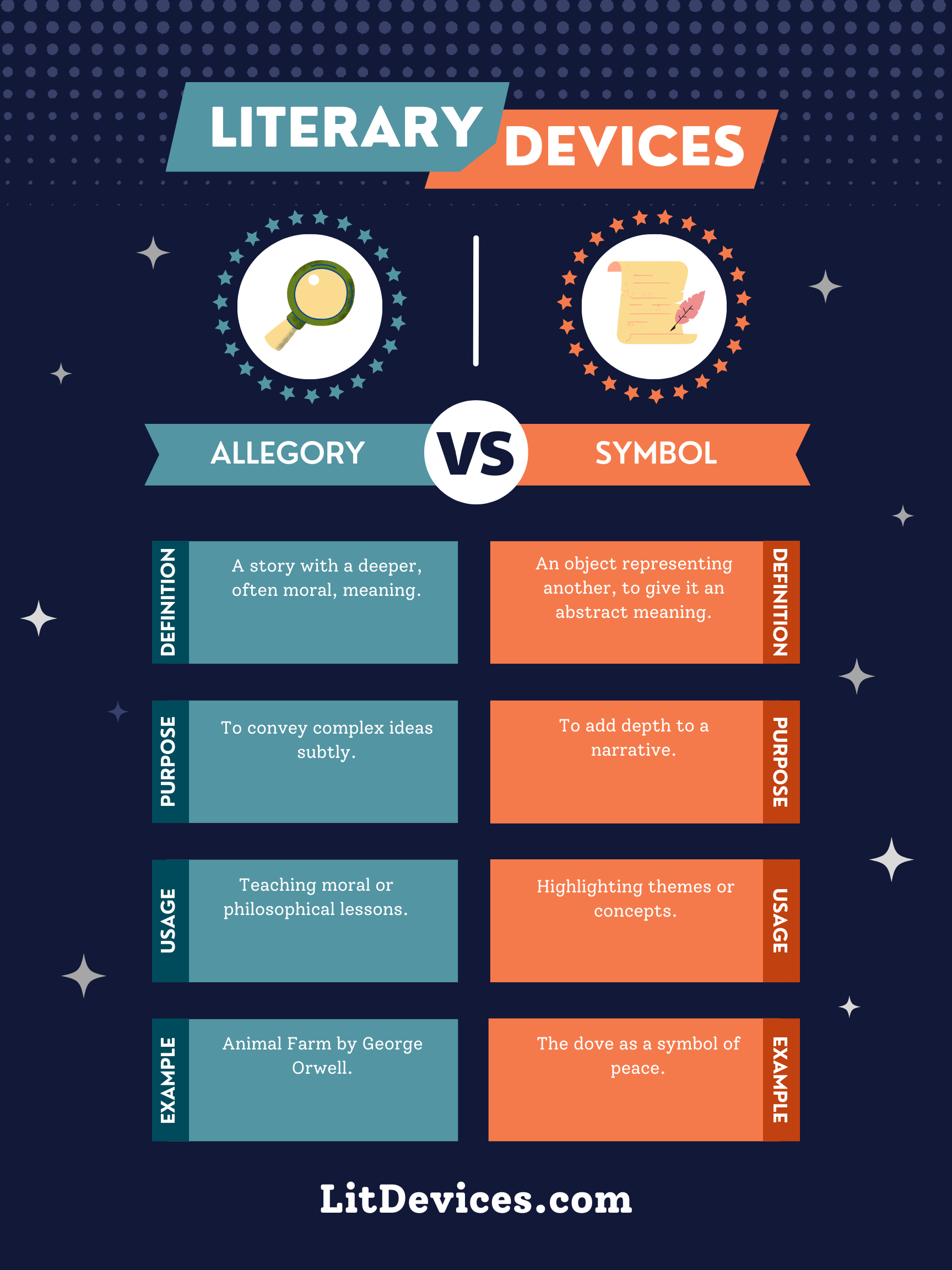Allegory is a narrative with a double meaning, often moral or political; Symbols represent ideas or concepts within a work.
Allegory
An allegory is an extended metaphor where characters, settings, and actions in a story have a dual meaning. Beyond the surface narrative, allegories are used to convey complex ideas and teach moral or political lessons through symbolic figures and storytelling.
📘 Example: “Animal Farm” by George Orwell is an allegory for the Russian Revolution and subsequent Soviet Union, where animals represent historical figures and ideologies.
Symbol
A symbol is a mark, sign, or word that indicates, signifies, or is understood as representing an idea, object, or relationship. Symbols allow writers to suggest layers of meaning and emotion, adding depth to the literary work without explicitly stating them.
🌹 Example: In literature, a rose often symbolizes love, beauty, or even secrecy, as in the phrase “sub rosa.”
Summary
| Literary Device | Definition | Purpose | Usage | Relevant Examples |
|---|---|---|---|---|
| Allegory | A story, poem, or picture that can be interpreted to reveal a hidden meaning, typically a moral or political one. | To convey complex ideas and teach lessons through symbolic figures and actions. | Used in narratives that require a deeper level of interpretation. | “Animal Farm” by George Orwell |
| Symbol | An object, character, figure, or color used to represent abstract ideas or concepts. | To add depth and layers of meaning to a story beyond the literal interpretation. | Common in all forms of literature, where symbols subtly convey deeper meanings. | The use of a rose to symbolize love or secrecy |
Writing Tips
When crafting stories or narratives using allegory or symbols:
- For Allegory: Plan your story’s deeper meaning before writing. Each character, setting, and event should align with the underlying message you wish to convey. This ensures coherence and richness in your allegory.
- For Symbol: Choose symbols carefully to ensure they enrich the narrative without confusing the reader. A symbol should add depth and intrigue, inviting the reader to explore its meaning.
🖋 Example for Allegory: Consider writing a story where a journey through a forest represents the journey of life, with each character the protagonist meets symbolizing different life stages or choices.
🖋 Example for Symbol: Use an object like a mirror to symbolize self-reflection or truth, weaving it into your story at critical moments to highlight character development or plot twists.
FAQs
What is the main difference between an allegory and a symbol?
An allegory is a complete narrative that represents another set of conditions or events, while a symbol is a single element within a narrative that represents a larger idea or theme.
Can a symbol become an allegory?
A symbol, if used extensively throughout a narrative to convey deeper meanings across the whole story, can contribute to an allegorical interpretation, but it typically remains a part of the broader allegorical framework rather than becoming an allegory itself.
How do allegory and symbol contribute to the depth of a literary work?
Both add layers of meaning, enriching the reader’s experience and engagement by encouraging deeper exploration of the text’s themes and ideas.
Exercise
Identify whether the following are examples of allegory or symbol:
- A story where a long, winding road represents life’s journey.
- A chain used repeatedly throughout a novel to symbolize the characters’ interconnected fates.
- A tale set in a dystopian future that critiques current social and political systems.
- A black cat appearing in several scenes, hinting at misfortune or mystery.
Answers:
Interesting Literary Device Comparisons
- Metaphor vs. Simile: While both draw comparisons, metaphors imply a direct correlation without using “like” or “as,” whereas similes make the comparison explicit.
- Foreshadowing vs. Flashback: Foreshadowing hints at future events in a story, building anticipation or suspense, while flashbacks provide background by revisiting past events.
- Irony vs. Satire: Irony involves stating something in a way that implies the opposite of the literal meaning, often for humorous or emphatic effect. Satire, meanwhile, uses humor, irony, exaggeration, or ridicule to criticize and expose flaws in society, individuals,

